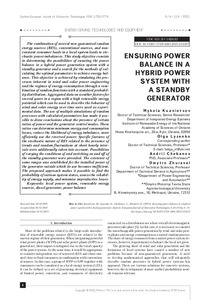Please use this identifier to cite or link to this item:
http://elar.tsatu.edu.ua/handle/123456789/16153Full metadata record
| DC Field | Value | Language |
|---|---|---|
| dc.contributor.author | Kuznietsov, M. | - |
| dc.contributor.author | Lysenko, O. | - |
| dc.contributor.author | Chebanov, A. | - |
| dc.contributor.author | Zhuravel, Dmytro | - |
| dc.contributor.author | Журавель, Дмитро Павлович | - |
| dc.contributor.author | Журавель, Дмитрий Павлович | - |
| dc.date.accessioned | 2022-02-01T09:13:57Z | - |
| dc.date.available | 2022-02-01T09:13:57Z | - |
| dc.date.issued | 2021 | - |
| dc.identifier.uri | http://elar.tsatu.edu.ua/handle/123456789/16153 | - |
| dc.description.abstract | The combination of several non-guaranteed random energy sources (RES), conventional sources, and non-constant consumer loads in a local system leads to stochastic power imbalances. This study objective consists in determining the possibilities of ensuring the power balance in a hybrid power generation system with a standby generator and a search for the methods of calculating the optimal parameters to achieve energy balance. This objective is achieved by simulating the processes inherent in wind and solar power engineering and the regimes of energy consumption through a combination of random functions with a standard probability distribution. Aggregated data on weather factors for several years in a region with a high renewable energy potential which can be used to describe the behavior of wind and solar energy over time were used as experimental data. The use of multiple simulations of random processes with calculated parameters has made it possible to draw conclusions about the presence of certain ratios of power and the generator control modes. These ratios can determine minimum energy and consumption losses, reduce the likelihood of energy imbalance, more efficiently use the reserved power. Specific features of the stochastic nature of RES related to the presence of trends and random fluctuations at short hourly intervals were additionally taken into account. Possibilities of varying the conditions of and switching on and off of the standby generator were provided. The existence of some ranges was established for the installed power of the generator outside which its use becomes inefficient. The proposed approach makes it possible to find the probability of various system states, assess the reliability of energy supply, and minimize unproductive losses. | uk |
| dc.language.iso | en | uk |
| dc.relation.ispartofseries | Eastern-European Journal of Enterprise Technologies;6 /8 (114) (Pp. 6-15) | - |
| dc.subject | local power system | uk |
| dc.subject | renewable energy sources | uk |
| dc.subject | diesel generator | uk |
| dc.subject | power balance | uk |
| dc.title | Ensuring power balance in a hybrid power system with a backup generator | uk |
| dc.type | Article | uk |
| local.identifier.doi | 10.15587/1729-4061.2021.24555 | uk |
| Appears in Collections: | кафедра Технічний сервіс та системи в АПК | |
Files in This Item:
| File | Description | Size | Format | |
|---|---|---|---|---|
| Dmytro Zhuravel_2021.pdf | 480.73 kB | Adobe PDF |  View/Open |
Show simple item record
CORE Recommender
???jsp.display-item.check???
Items in DSpace are protected by copyright, with all rights reserved, unless otherwise indicated.
